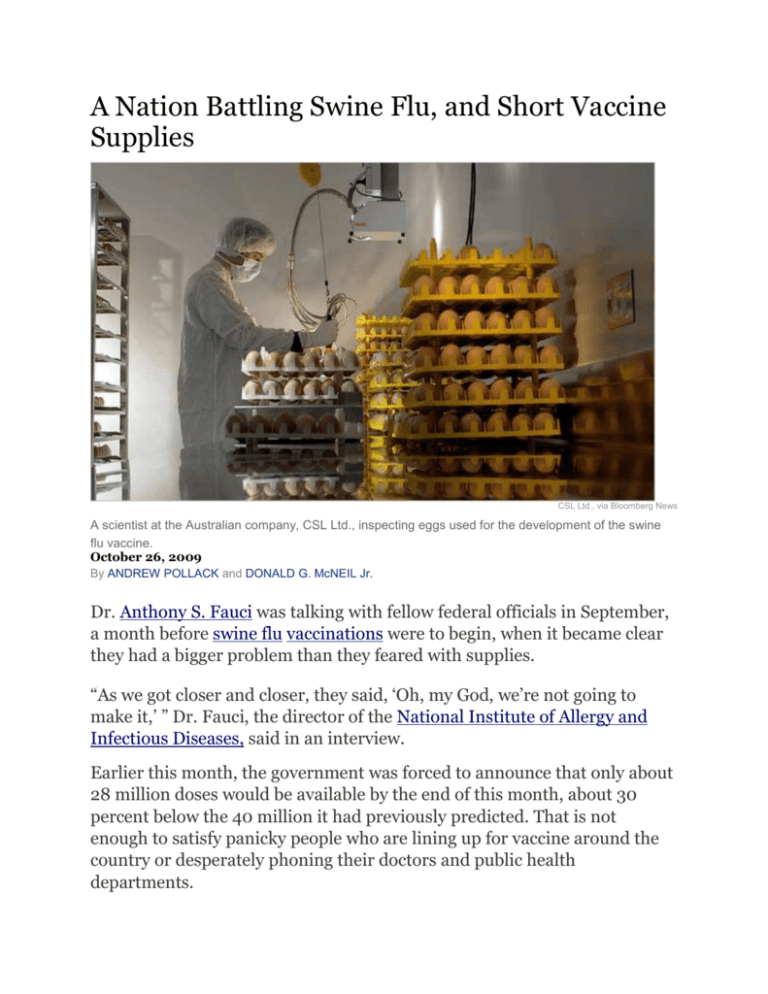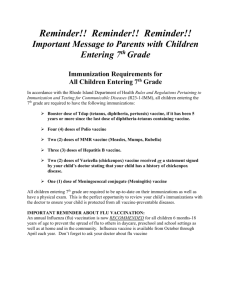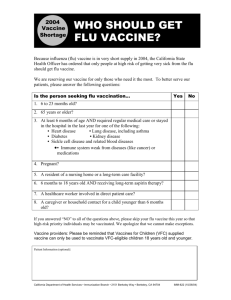A Nation Battling Swine Flu, and Short Vaccine Supplies
advertisement

A Nation Battling Swine Flu, and Short Vaccine Supplies CSL Ltd., via Bloomberg News A scientist at the Australian company, CSL Ltd., inspecting eggs used for the development of the swine flu vaccine. October 26, 2009 By ANDREW POLLACK and DONALD G. McNEIL Jr. Dr. Anthony S. Fauci was talking with fellow federal officials in September, a month before swine flu vaccinations were to begin, when it became clear they had a bigger problem than they feared with supplies. “As we got closer and closer, they said, ‘Oh, my God, we’re not going to make it,’ ” Dr. Fauci, the director of the National Institute of Allergy and Infectious Diseases, said in an interview. Earlier this month, the government was forced to announce that only about 28 million doses would be available by the end of this month, about 30 percent below the 40 million it had previously predicted. That is not enough to satisfy panicky people who are lining up for vaccine around the country or desperately phoning their doctors and public health departments. But the October shortfall was not the first. Indeed, since the outbreak of the H1N1 swine flu occurred in April, federal projections have been consistently and wildly overoptimistic and have had to be ratcheted down several times. As recently as late July, the government was predicting having 160 million doses by this month. The reasons for the receding estimates start with the fact that the H1N1 virus, known as swine flu, is not growing as fast as expected in the eggs used to produce vaccine. Moreover, some manufacturers did not even know how little they were producing until a vaccine potency test became available around August, federal officials say. Some companies hit bottlenecks in putting the vaccine into vials and syringes. And an Australian company, CSL Ltd., satisfied its own country’s needs first. Federal officials argue, and some outside experts agree, that the government did a good job in rapidly marshaling suppliers of vaccine for the flu pandemic. The first doses were administered early this month, faster than in any other countries except China and Australia. And inoculations started only about five months after the swine flu outbreak started in Mexico, which is quicker than it takes to get a seasonal flu vaccine ready. But, these experts say, the government’s accomplishments, and its credibility, are being undermined by overly rosy projections that did not take account of the vagaries of vaccine production, making it look as if the vaccine effort is failing. “To my mind, it was over-promising what there would be based on our historic experience with flu vaccines,” said Michael T. Osterholm, director of the Center for Infectious Disease Research and Policy at the University of Minnesota. “When you plant corn in May in Iowa, you have no idea what your harvest is going to be in October,” Dr. Osterholm said. “You have to factor in hailstorms, floods and whatever. They put out a very high yield estimate early on. Every time they had to back off, they lost credibility.” Federal officials say they factored such difficulties into their projections. They say they were pressed to make the projections by state and local health officials and by the news media. Still, they said, they relied on assurances from the vaccine manufacturers, some of whom might have been overconfident of their ability to resolve production problems. “I think it’s fair to say that some were overly optimistic, thinking the fix was just around the corner,” said Dr. Nicole Lurie, the assistant secretary for preparedness and response at the Department of Health and Human Services. Dr. Lurie said some manufacturers had informed the government of their latest shortfalls only around Columbus Day earlier this month. Some of the companies say they kept the government informed all along. “All the data is completely transparent to the government,” said Andrin Oswald, the head of the vaccines business at Novartis. “The contract always was yield-dependent,” Mr. Oswald said. And Novartis, he said, initially was getting only about one-quarter as much vaccine per egg as it typically gets for seasonal vaccine. The company was hoping to produce 90 million doses in bulk form by the end of November. It is now scrambling to accomplish that before the end of the year. Many of the projections originated from the Biomedical Advanced Research and Development Authority, or Barda, a part of Health and Human Services, which is responsible for vaccine contracting for emergencies. In April, an official with the agency predicted that as many as 600 million doses could be available by January, if all went well. From May through September, Barda signed contracts worth $1.5 billion for about 250 million doses of vaccine with five companies. The contract volumes were based basically on what each company said it could provide. These were the same companies that produce seasonal flu vaccine for the United States, making it easier for the swine flu vaccines to win regulatory approval. And, said Dr. Thomas R. Frieden, the director of the Centers for Disease Control and Prevention, “We really thought that having five different manufacturers would buy us some insurance, that they wouldn’t all have problems.” By late May, vaccine manufacturers were provided so-called seed strains of the H1N1 virus that would be grown in eggs to make the vaccine. “We thought we were done,” said Doris Bucher, who runs a laboratory at New York Medical College that makes seed strains. “We were ready to break out the champagne.” But within three weeks, Dr. Bucher said, vaccine manufacturers were reporting that seed strains were not growing well. Her laboratory and others then developed better strains but they were not ready until August. Wayne Pisano, the president of vaccine maker Sanofi Pasteur, said his company was at first getting only 1.5 doses of swine flu vaccine from each egg, compared with the 3 to 4 doses it typically gets for seasonal H1N1 strains. Since then the company has improved its yield to 3 doses per egg. Sanofi, however, ran into some delays putting the vaccine into vials and syringes. It also had some yield problems with the seasonal flu vaccine. “We’re basically balancing between completing the seasonal production and the H1N1,” Mr. Pisano said. Sanofi Pasteur had been aiming to deliver 20 million doses by the middle of October. It is likely to deliver about 16 million by the end of the month, he said. Another bottleneck was the development of a potency test to tell how many doses are being produced in each egg. Development of the potency test, done by various government and private laboratories, itself requires growing the vaccine in eggs, and inoculating sheep to harvest their antibodies. Dr. Lurie said that once potency testing was done, some companies found they had less vaccine than they thought. One company that did not have yield problems was MedImmune. It produces the live virus nasal spray vaccine and uses a unique seed strain. It is supplying 40 million doses to the government but is limited by its capacity to put the vaccine into the nasal sprayers. The fifth manufacturer, GlaxoSmithKline has not yet gotten Food and Drug Administration approval for its vaccine. While the other four companies got such approval in mid-September, Glaxo did not even apply until early that month. But Glaxo’s contract calls for it to deliver only 7.6 million doses. Some critics say that if the government did anything wrong, it was not investing earlier and more heavily in new technologies that could produce vaccine faster than in eggs. Federal officials say that they have invested, but that the technology would not have been ready by now, even if more money had been spent. “We had no choice, zero choice, but to go with the reliable but fragile eggbased technology,” Dr. Fauci said. Federal officials are now getting gun shy of making supply projections. When Dr. Frieden of the disease centers was asked at a news conference Friday when there would be enough vaccine for everyone who wanted it, he replied only that more would be available in the next several weeks. “We’ve had difficulty with the projections we’ve had so far,” he said.






